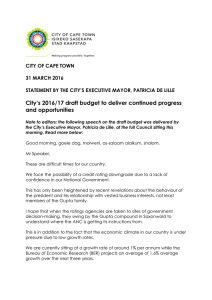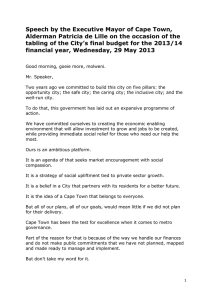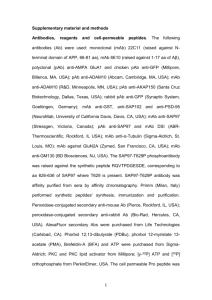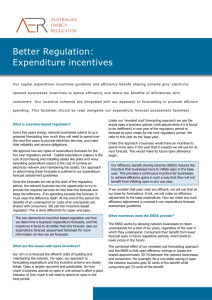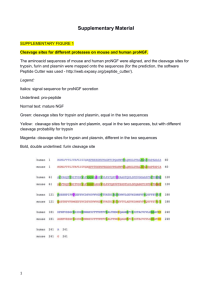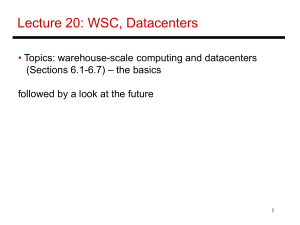CAPEX and OPEX
advertisement
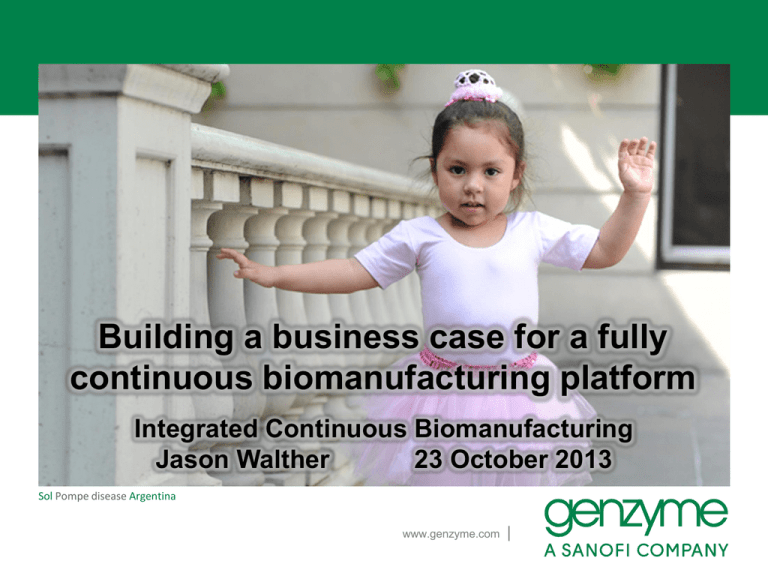
Building a business case for a fully continuous biomanufacturing platform Integrated Continuous Biomanufacturing Jason Walther 23 October 2013 Sol Pompe disease Argentina www.genzyme.com | Fully continuous biomanufacturing platform • Genzyme developing a continuous integrated platform − Technical results are promising − But can we justify the platform from a business perspective? − And can we use economic modeling to guide development? 2 Economic drivers for the continuous platform CAPEX Universal platform OPEX Risk Omni-product facilities Common work force Flexible infrastructure Step reduction Smaller facilities Simpler process Volume reduction Smaller facilities No scale-up Single-use tech More automation Faster build times Reduced turnaround Increased complexity Less labor Steady state High-productivity Consistent operation Smaller facilities Closed process Steady quality Media requirements • Can we quantify these advantages and disadvantages? 3 Financial valuation methodology • • • • Estimate CAPEX/OPEX using BioSolve software Estimate platform dev costs and lay out a future product timeline Predict discounted cash flows for legacy & continuous platforms Calculate financial indicators (e.g., NPV) and make assessment Facility Estimates Cash Flow Projections Financial Indicators CAPEX/OPEX savings using the new platform Discount future costs CVI, NPV, IRR, etc. Development Costs Launch Scenarios Inputs Assessment Outputs Facility estimates: CAPEX and OPEX • Use BioSolve software package − Define process (unit ops, scaling rules, assumptions) − Calibrate cost data (equipment, materials, labor, etc.) − Benchmark against previous internal and external projects Facility A Facility B Facility C Facility D Facility E Facility Scale (Reactor # and Size) Facility CAPEX (Actual:Estimated) 4X20,000L 12X12,000L 6X15,000L 3X10,000L 3X4,000L 104% 101% 101% 102% 120% − Biosolve capital estimates are acceptably accurate 5 Facility estimates: Platform assumptions Legacy Platform mAb 500 kg/y Enzyme 20 kg/y 6 US DS Time IVCD Titer US Fed-batch 1X10,000L SS Batch 12 days 3000 Mcell·h/mL 3.5 g/L Microcarrier perfusion 2X2,000L SS DS Batch Time 60 days VCD 5 Mcell/mL Titer 0.05 g/L Continuous Platform US Suspension perfusion 2X500L SU DS Continuous Time 60 days VCD 100 Mcell/mL Titer 1.4 g/L US Suspension perfusion 1X500L SU DS Continuous Time 60 days VCD 100 Mcell/mL Titer 0.5 g/L Facility estimates: Platform assumptions CAPEX ($M) mAb OPEX ($/g) Legacy 500 kg/y 2X 1.2X 1X 1X Continuous Enzyme 20 kg/y 1X 7 50X 3X 8X Cost impacts of the fully continuous platform mAb OPEX Overall: –54% Overall: –20% % overall cost mAb CAPEX 8 Cell-Specific Perfusion Rate CAPEX/OPEX sensitivity analyses Red = More Savings CAPEX Savings OPEX Savings (Fed-Batch mAb – Continuous mAb) (Fed-Batch mAb – Continuous mAb) Viable cell density • Financial estimates can guide process development − (For example, CSPR and VCD targets) 9 CAPEX/OPEX sensitivity analyses Red = More Savings Cell-Specific Perfusion Rate ΔNPV for a single facility (Fed-Batch mAb – Continuous mAb) Viable cell density • Financial estimates can guide process development − (For example, CSPR and VCD targets) 10 Financial valuation methodology Facility Estimates Cash Flow Projections Financial Indicators CAPEX/OPEX savings using the new platform Discount future costs CVI, NPV, IRR, etc. Development Costs Launch Scenarios Inputs Assessment Outputs Product launch scenario 2025 2026 2027 2028 2029 2030 2031 2032 • Create a hypothetical product timeline with various mAb and enzyme product launches • Calculate NPV for two scenarios − Legacy platforms (fed-batch and microcarrier perfusion) − Universal continuous platform • Compare NPVs to estimate value of new platform 12 Advanced Modeling – An Integrated Approach Sales Profiles Product Definition Dashboard Development Profiles Stocking Strategy In partnership with Biopharm Services Ltd. 13 Product NPV Portfolio NPV Manufacturing Network Relative cash flow projections ΔNPV for product portfolio mAb OPEX Enzyme OPEX mAB CAPEX Enzyme CAPEX Development Cost discount rate = 7% • Clear benefits to new platform (given the assumptions) • Hundreds of millions of dollars in potential savings 14 Relative cash flow projections ΔNPV for product portfolio High demand Medium demand Low demand • Different product launch scenarios can be investigated • Continuous platform competes in a variety of scenarios 15 Conclusions • Infrastructure in place for economic modeling of future platforms • Preliminary analysis shows strong, quantifiable business drivers for continuous platform − We will continue to revisit and improve assumptions − Additional sensitivity analyses − Expand comparisons to other platforms (e.g., disposable FB) • Process development guidance − Cell density and CSPR are influential upstream parameters − Similar parameters will be found for downstream process 16 Acknowledgments • Genzyme Late Stage Process Development • Genzyme Capital Finance • Genzyme Industrial Affairs • Sanofi Biologics Research & Development • Biopharm Services 17

